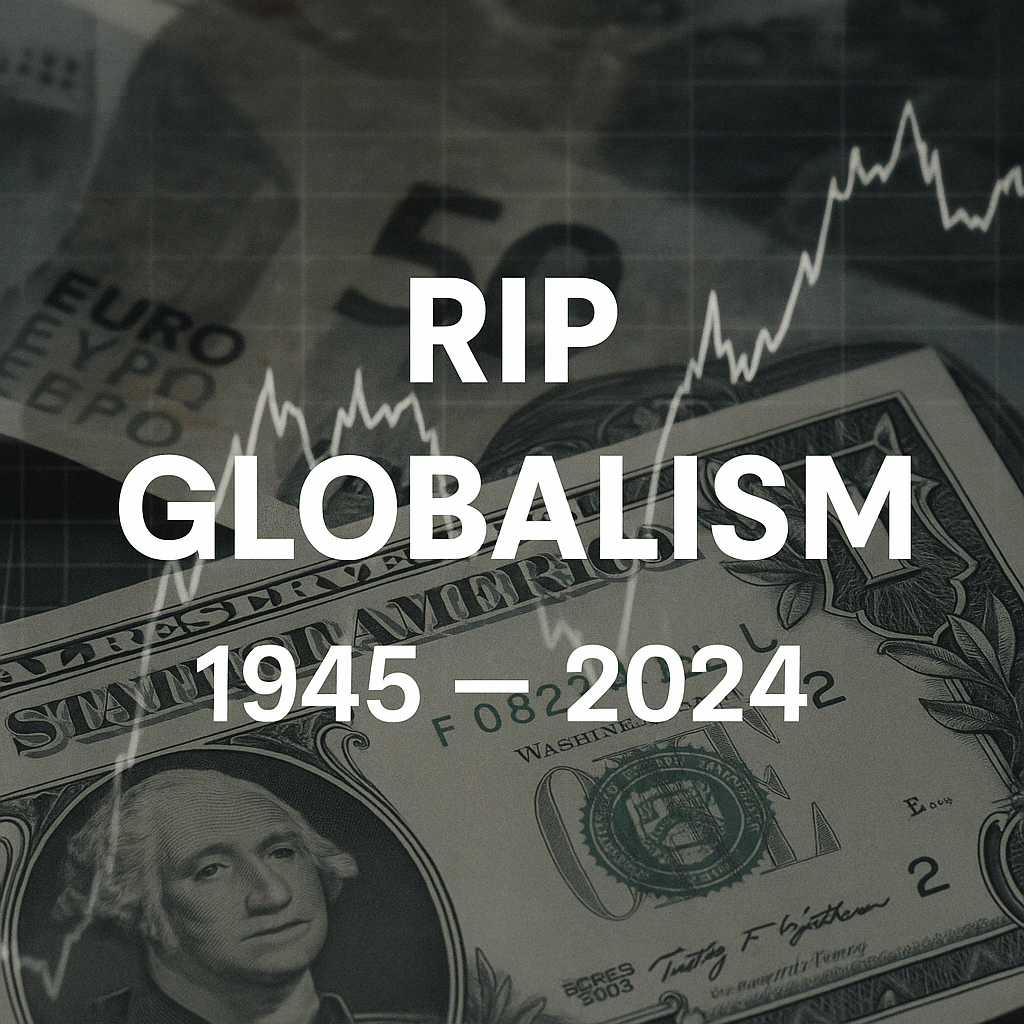RIP Globalism: 1945–2024

The End of an Era and the Birth of a New Economic Order
For nearly 80 years, globalism was the defining framework of American economic and foreign policy... That era is now over.
The Arc of Globalism (1945–2024)
- 1945–1971: Bretton Woods, Marshall Plan, IMF, World Bank
- 1970s–1990s: Deregulation, NAFTA, WTO, multinational expansion
- 2000s–2010s: China's rise, hyper-financialization, inequality
2024: The Breaking Point
- Strategic tariffs imposed to weaken the dollar
- Shift from openness to protectionism in immigration and land policy
- New economic doctrines challenge free-market globalism
The New Paradigm: Sovereignty Over Systems
- Devalue the dollar to boost exports
- Reshore manufacturing
- Use tariffs for leverage
- Limit foreign capital inflows
The Dollar Dilemma: Weaker Currency as a Strategic Tool
Central to this economic reset is the belief that the U.S. dollar must be weakened to make American exports competitive again. A strong dollar, while good for Wall Street and foreign buyers of U.S. assets, has made it harder for Main Street and the American manufacturers to sell abroad and compete with imports at home. By discouraging foreign capital inflows and resetting interest rate incentives, the Trump administration is betting on a structural shift: a cheaper dollar that favors producers over speculators.
This transition could have profound consequences for middle- and working-class Americans. On one hand, it will likely lead to higher prices for imported goods—everything from electronics to food—effectively raising the cost of living. On the other, it's possible it will spur a revival in domestic production, creating more blue-collar jobs and lifting wages in sectors long considered dead. Whether this trade-off pays off will depend on how fast industry scales, and how well policymakers cushion the blow of inflation in the interim.
Insights from Stephen Miran’s Framework
Economist Stephen Miran, in his paper A User's Guide to Restructuring the Global Trading System, outlines a strategy for overhauling international trade. He emphasizes that the persistent overvaluation of the U.S. dollar hampers American manufacturing competitiveness. Miran advocates for tariffs and currency policy adjustments to address these challenges. He proposes a coordinated approach that intertwines economic policy with national security considerations.
Notably, Miran discusses the potential for a "Mar-a-Lago Accord," a modern counterpart to the 1985 Plaza Accord. This aims to realign currency values through multilateral agreements. He also explores unilateral tools available to the U.S., such as using the International Emergency Economic Powers Act (IEEPA) to influence currency markets. These strategies aim to redistribute the financial burdens of global reserve currency provision and defense commitments more equitably among international partners.
For a detailed exploration of these concepts, refer to Miran's full paper: A User's Guide to Restructuring the Global Trading System.
Can This Work? A Model of Probable Outcomes[1]
| Time Frame | Expectations | Probability of Success |
|---|---|---|
| 0–18 months | Inflation, consumer pain, market volatility | 10–20% |
| 18 months–5 years | Industrial recovery or strategy collapse | 20–25% |
| 5–15 years | Structural realignment of trade & sovereignty | 30–40% |
| Failure Risk | Stagflation, capital flight, loss of global leverage | 50–60% |
What Died, and What’s Being Born
RIP Globalism. In less than 100 days by the words and actions of the Trump administration, gone is the perception that we could run persistent deficits and float on financial dominance forever.
In its place rises a new, messy, confrontational worldview: industrial sovereignty, controlled capital, and territorial identity.
Conclusion: The Funeral Is Over. Now Time Will Tell.
The death of globalism isn’t just a policy shift—it’s a cultural and generational realignment. The world is watching to see whether this new experiment ends in rebirth—or ruins.
History will judge. But 2024, in my view, will be remembered as the year the music stopped.
📚 Sources Referenced
-
Porter, Eduardo.
I think I figured out the ‘4D chess’ Trump is playing with the world.
The Washington Post, April 14, 2025 -
Sit, Leon, and Max McCall.
Trump’s economic gamble is rattling markets—and voters.
The Washington Post, April 14, 2025 -
DiPlacido, Mark A.
A New Trade Paradigm.
American Compass, March 14, 2025 -
McGeever, Jamie.
U.S. 'strong dollar' policy rings increasingly hollow.
Reuters, April 15, 2025 — quoting Dr. Stephen Miran on capital flow constraints and currency revaluation. -
Miran, Stephen.
A User’s Guide to Restructuring the Global Trading System.
Hudson Bay Capital -
Historical Context:
Nixon Shock (1971), Plaza Accord (1985), Reagan-era Japan trade policies — all used as historical analogues for today’s economic strategy.
[1] This probability model was generated in collaboration with OpenAI's GPT-4 language model based on economic policy trends and historical analogues as of April 2025.